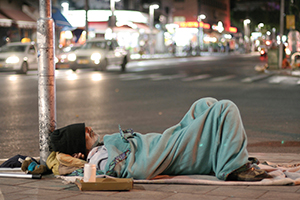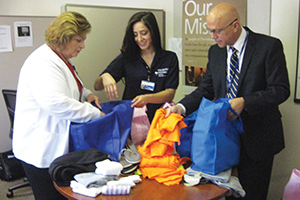By NANCY FRAZIER O'BRIEN
When the city of Los Angeles declared homelessness a public emergency last fall, it came as no surprise to those in Catholic health care who have been working with the homeless for decades.
"One of the leading needs in our area is working with the homeless," said Sr. Colleen Settles, OP, vice president of mission for Providence Saint John's Health Center in Santa Monica, Calif., in Western Los Angeles County. Providence Saint John's is a part of Providence Health & Services. "It's been the highest need in our community for some time."

© Paul Prescott/Thinkstock
With nearly 26,000 people homeless in Los Angeles on any given night, the city has declared that homelessness is a public emergency.
Los Angeles officials estimate that there are nearly 26,000 homeless people in the city on any given night, with only about 8,000 of them in shelters. As many as 254,000 men, women and children experience homelessness in Los Angeles County during some part of the year, according to the Institute for the Study of Homelessness and Poverty at the Weingart Center, a nonprofit agency in Los Angeles.
Unintended consequences
But some "unintended consequences" of the Affordable Care Act have presented new challenges in providing health care for the homeless, especially those in need of mental health assistance, Sr. Settles said.
"Historically we were able to contract with mental health providers so that when we had homeless patients with mental health issues … we would be able to transfer them to the care that they needed, knowing they would not be able to pay but that we could pay as part of our charity care," she said.
However under Medi-Cal, the California Medicaid program, "it is no longer legal for us to pay for care for those who are insured," and Providence Saint John's could no longer contract with other organizations to take patients, she said. Many of the homeless had been enrolled in Medi-Cal months or years earlier, but have no idea who their health care provider is or where to go for care, she added.
As a result, "some of our psychiatric patients were being held in the emergency department for days without being able to be transferred ... so that they could get the treatment and medication they needed," Sr. Settles said. Providence Saint John's does not have any psychiatric beds, and it refers or transports those in need to not-for-profit programs that aid the homeless. Sr. Settles said Exodus Recovery, which provides addiction and mental health services under its contract with the Los Angeles County Department of Mental Health, recently reopened a 24-hour, mental health urgent care center for the seriously mentally ill in Western Los Angeles County. Providence Saint John's refers patients there.
Piecing services together
Three other Providence facilities in the area use a new "telepsych" program to connect, via an iPad, emergency room patients with psychiatrists who work under contract with Providence. With a nurse in the patient's room, the psychiatrist can talk with and assess the patient "to determine if they can be taken off (a psychiatric) hold or whether they should start on some psychiatric medicine," Sr. Settles explained.

With nearly 26,000 people homeless in Los Angeles on any given night, the city has declared that homelessness is a public emergency.
Photo courtesy of Providence Tarzana Medical Center
Providence Saint John's recently hired a patient advocate specifically to "walk with the homeless patients as they are discharged to make sure they actually get the kind of care they need" and to connect them with resources available from OPCC (formerly the Ocean Park Community Center), a social services agency that integrates mental health with all its services and programs including life skills training, housing and addiction treatment and a respite program for homeless individuals recuperating from illness or injury.
The respite program allows the homeless who need medical care to remain in a local shelter during daytime hours, rather than having to leave during the day as commonly required, so that "they are not roaming the streets until they are better," Sr. Settles said.
Caring for the medical and mental health needs of the homeless is just one part of the assistance that is provided by Catholic health systems.
Clothed in kindness
A program called Ease my Way at Providence Tarzana Medical Center in the Los Angeles neighborhood of Tarzana arose from concerns voiced by the staff about homeless patients not having appropriate clothing for discharge, said Shawn Kiley, the hospital's director of mission leadership.
"We don't want to discharge them with just a hospital gown," Kiley said. "We wanted to bring dignity and respect to those who are in this situation."
Through periodic collection drives among the staff, Providence Tarzana offers homeless patients an Ease my Way bag with new clothing, shoes and hygiene and comfort items that they can take with them. The kits, available for men and women, include a new set of sweatshirt and sweatpants, undergarments, socks, earplugs, hand and body lotion and hand sanitizer, as well as other items. The clothing is available in a variety of sizes.
"Every six months we try to replenish our inventory" with another collection drive, Kiley said. "When we do a collection drive we take inventory and can tailor what our inventory has depleted." Men's sweats in large and extra-large are the most requested, he said.
California's crisis
According to the U.S. Department of Housing and Urban Development's "The 2015 Annual Homeless Assessment Report to Congress," California accounted for 26 percent of the nation's homeless population on the single night in January 2015 when a point-in-time count was made nationally to estimate the number of sheltered and unsheltered homeless. At 64 percent, California had the highest percentage of people counted in unsheltered locations.
Los Angeles had a 20 percent rise in homelessness between the 2014 and 2015 point-in-time reports.
In addition to Los Angeles, San Diego city and county, San Francisco, and San Jose and Santa Clara city and county are among the top 10 urban areas for homelessness identified in the 2015 report.
Permanent housing
Jim Tehan, director of community partnerships in Providence's South Bay region south of Los Angeles, said that while finding permanent housing is the goal of homeless service providers, acclimating to a different lifestyle in stable housing can present another set of challenges to some people who have been homeless for long periods.
"The first three months are most vulnerable to them going back to their old setup because they feel isolated or lost," Tehan said. "So we have an outreach worker whose role is to cover the health care side of the equation — do they know who their doctor is, are they going to appointments? Are they getting the level of support they need for substance abuse treatment or chronic conditions? It's just one more factor where people can fall out.
"It's all about keeping people in housing," he added.
Copyright © 2016 by the Catholic Health Association
of the United States
For reprint permission, contact Betty Crosby or call (314) 253-3477.